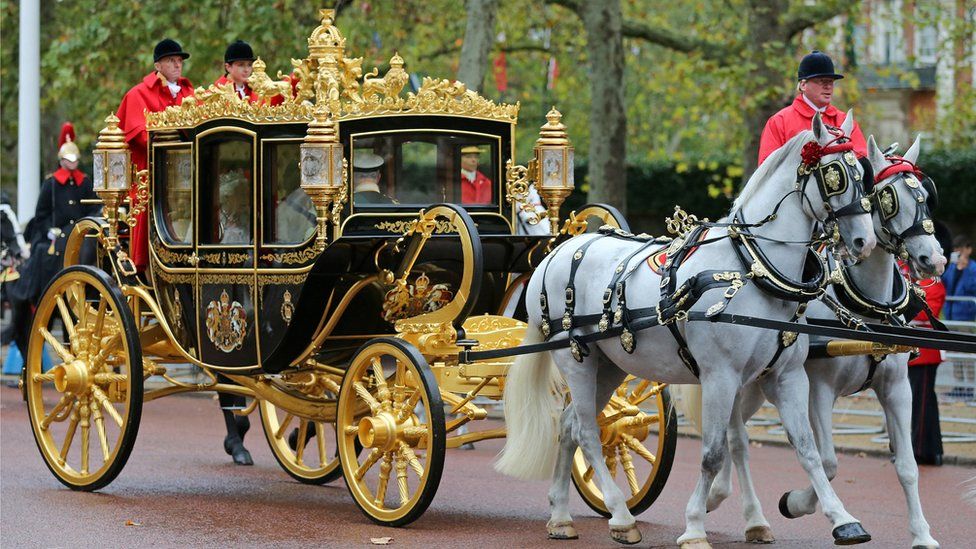
The King and Queen Consort will travel to the coronation at Westminster Abbey in a more comfortable, relatively modern, horse-drawn carriage.
They will ride in the Diamond Jubilee State Coach, first used in 2014, in plans revealed by Buckingham Palace.
But they will return to the palace in the traditional - but notoriously uncomfortable - Gold State Coach, used in every coronation since the 1830s.
Crowds can watch the procession going along the Mall and Whitehall in London.
The carriage procession will be one of the spectacular sights of the coronation on 6 May.
It will head out from the gates of Buckingham Palace carrying the royal couple and other members of the Royal Family, travelling to Westminster Abbey where the coronation service will begin at 11:00 BST.
But instead of the Gold State Coach, the King and Camilla, the Queen Consort, will be in the newest of the royal carriages, the Australian-built Diamond Jubilee State Coach.
This looks traditional, but is actually modern, with air conditioning, electric windows and up-to-date suspension.
"It's made of aluminium, which is quite unusual, because most of them are made of wood, and it's also got hydraulic suspension, meaning that the ride is incredibly comfortable," says Sally Goodsir, curator at the Royal Collection Trust.
It incorporates pieces of wood from historic ships and buildings, including HMS Victory, the Mary Rose, Balmoral Castle, Canterbury Cathedral and Westminster Abbey.
Viewed close up at the Royal Mews, the carriages are an explosion of gold and glass and polish. They are basically crowns on wheels.
But the royal couple will be spared a bumpy ride on the way to the Abbey. Recalling her coronation in 1953, Queen Elizabeth had described the ride in the 18th-Century gold state coach as "horrible" and "not very comfortable".
One of her predecessors, William IV, crowned in 1831, described his trip in the carriage as like being on a ship "in a rough sea".
Buckingham Palace has not commented on the reason for the switch.
But even if the Gold State Coach has its drawbacks, it is a remarkable piece of craftsmanship, with elaborate carvings under a thin layer of gold and panels covered in paintings. It may be uncomfortable but it is a rolling work of art.
Helping the four-tonne carriage to make the journey will be Martin Oates, who will be the carriage's brakeman on coronation day.
He follows his great-grandfather who took part in the carriage procession for the coronation of George VI, his grandfather who was there for the coronation of Elizabeth II and his father for the late Queen's Silver Jubilee in 1977.
"When you're walking down The Mall, you do think of all the family members who have been part of it," said Mr Oates, speaking at the Royal Mews at Buckingham Palace, where the carriages are kept.
Head coachman Matthew Power said the "hairs go up on the back of your neck" on such an occasion, but it was important to stay calm and to stop the horses from getting nervous.
"The horses know it's going to be a big day and you have to be the calm one and say it's just another day at the office," said Mr Power.
The procession will go from Buckingham Palace, along The Mall to Trafalgar Square, along Whitehall to Parliament Square and then to Westminster Abbey. The return will be the same route in reverse.
The coronation ceremony will use the traditional regalia, such as symbolic rings and swords, as well as the crowns, including the St Edward's crown which will be placed on the King's head.
The sceptres being used will include one from the 17th Century made from ivory, after speculation that it might be withdrawn because of animal conservation concerns.
The oldest item being used will be a spoon to hold the oil for the anointing in the coronation. This spoon, possibly 12th Century, is a rare surviving part of the original medieval coronation regalia, most of which was destroyed after the English Civil War in the 17th Century.
Among more than 2,000 guests expected to be in the Abbey will be 450 representatives of charity and community groups, who will be alongside world leaders, politicians and royalty.
There have been complaints about the cost of the coronation from anti-monarchy campaigners. In terms of the public expenditure, the government will not publish a figure until after the event.
When the procession comes back to Buckingham Palace, the newly-crowned Charles and Camilla will appear on the balcony, alongside other senior members of the Royal Family.
Last year, for the late Queen's Platinum Jubilee, only working royals were allowed on the balcony, excluding those such as Prince Harry and Prince Andrew who had stepped down from royal duties.
And proving this is a 21st Century coronation, a special emoji has even been created for the occasion.
Related Topics
-
- 7 March
-
- 4 days ago
from Via PakapNews